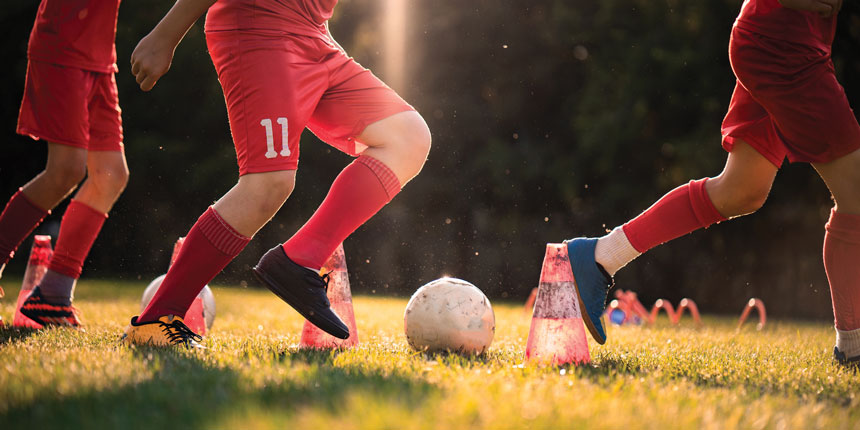Health+
Prevent Overuse Injuries in Young Athletes

How to help your kids avoid sports burnout
Many parents look back fondly on neighborhood pick-up games and playing hopscotch until the stars came out. Today, sports are still an important part of childhood, but often with less spontaneity.
About 30 million U.S. children and adolescents currently participate in organized sports, according to the Centers for Disease Control and Prevention (CDC). On one hand, that’s a victory. An active life beginning at a young age comes with seemingly endless benefits, including reduced risk of obesity and diseases such as cancer, heart attack, stroke and diabetes. On the other hand, the American Academy of Orthopedic Surgeons (AAOS) notes a significant increase in overuse injuries in children, with most of these injuries sports-related.
Are we cheering on our children to the breaking point?
Win a Few, Lose a Lot
“Overuse injury is caused by excessive repetitive motion, and it can be a serious problem for younger athletes who specialize in one sport year-round, doing the exact same moves over and over without giving their body a break,” says Dr. Joseph Lifrak, a Sports Medicine Orthopedic Surgeon at Southcoast Health and Team Physician for the Providence College Friars hockey team.
Dr. Lifrak describes a common scenario that can lead to overuse injury: A child plays baseball in the summer, attends baseball clinics in the fall and winter, begins intense training in the spring and then the cycle starts again. “This kind of constant stress is tough on every athlete at any age,” Dr. Lifrak emphasizes. “For a child whose bones are still growing and developing, this level of repetition can lead to injury, chronic pain and possibly even impaired growth. Their bodies just can’t take it.”
Making matters worse, Dr. Lifrak adds, many young athletes play their preferred sport 12 months a year and on multiple teams, like a school team, a traveling team and a city team. “That’s another reason why we’re seeing an increase in overuse injuries in children.”
Confirming Dr. Lifrak’s expert opinion is a recent study that looked at about 5,600 athletes age 18 or younger. Compared to athletes who played a wide variety of sports, youth who specialized the most were 81% more likely to experience an overuse injury.
Keep Your Eye on the Ball
Parents and coaches should look for these four signs to recognize when a child may be headed for or suffering from an overuse injury:
- Pain. If a child experiences chronic pain yet there’s no singular injury or accident to pin the pain on, it’s time to seek medical help and discuss the possibility of an overuse injury.
- Swelling. When a child’s joint swells up and needs to be repeatedly iced down, but there’s no identifiable moment of injury, this is a sign of overuse.
- Changes in form or technique. If, for example, your son or daughter starts throwing the ball differently — without a coach introducing a new technique — it might mean the child is making accommodations for physical pain from an overuse injury.
- Lack of interest in the sport. Burnout can be due to emotional issues as well as physical reasons. “The child may be trying to relieve their pain by simply not playing any more. I see this a lot in my office. In fact, I see more physical burnout than emotional burnout,” Dr. Lifrak says.
A Whole New Ballgame
To help young athletes avoid overuse injuries, Dr. Lifrak says it’s important to discourage specializing in one sport 12 months a year. Instead, he says, encourage your child to play a variety of sports with the changing seasons. This reduces excessive, repetitive movements and gives certain muscle groups time to rest and recuperate. The American Academy of Pediatrics recommends that young athletes take a cumulative three-month break per year from a specific sport. Time off can be consecutive months or divided throughout the year in one-month increments.
In addition to taking a break, it’s best to limit game time to one league or team per sport per season. “We want children to stay active year round. But playing on five different teams and practicing every night — that’s a perfect storm for an overuse injury,” Dr. Lifrak says.
If a young athlete digs in their cleats and refuses to pull back on that favorite sport, Dr. Lifrak suggests a compelling argument: “As team physician for the Providence College hockey team, I’ve learned that the best athletes build their whole bodies. So, for example, if basketball is your child’s sport, encourage them to go out for cross-country or soccer in the fall — two sports that build up leg muscles. Now your child is a stronger player overall with more endurance, less risk of overuse injury and physically, in much better shape to go for the win.” 
Learn more about Southcoast Health’s orthopedic and sports medicine services.
